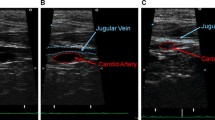Abstract
Objective: To evaluate cerebral perfusion using direct cannulation into the common carotid artery. A new technique is needed to protect brain ischemic injury during ascending aortic or aortic arch replacement. Methods: This technique was evaluated for patients who would have difficulty maintaining adequate cerebral perfusion during surgery. The procedure was performed when patients had the following diagnoses: pseudoaneurysm formation in contact with the sternum with the risk of aneurysmal rupture (n=5), acute aortic dissection with compression of the true lumen of the innominate artery by the pseudolumen (n=3), or a large volume of thrombus in the lumen of the aneurysm with the risk of cerebral thromboembolism if standard extracorporeal circulation was used (n=2). The perfusion catheter was cannulated into one side of the common carotid artery (right side: n=6, left side: n=4) and mean perfusion flow rate was found to be 175 mL/min. The operative procedures consisted of ascending aortic and aortic arch replacement with coronary artery bypass grafting in six patients, ascending aortic replacement in 2 patients, and innominate artery reconstruction/innominate artery and right subclavian artery reconstruction in one patient. Results: No cerebral accidents or deaths occurred while patients were hospitalized. We have followed up patients for a mean of 2.1 years (maximum 3.6 years), with no complications noted from the surgical procedure. Conclusions: Direct cannulation of the common carotid artery is a simple, safe, and acceptable cerebral protection for patients undergoing aortic or aortic arch replacement procedures in the patients with these specific conditions.
Similar content being viewed by others
References
Svensson LG, Crawford ES, Hess KR, Coselli JS, Raskin S, Shenaq SA, et al. Deep hypothermia with circulatory arrest: Determinants of stroke and early mortality in 656 patients. J Thorac Cardiovasc Surg 1993; 106: 19–31.
Safi HJ, Brien HW, Winter JN, Thomas AC, Maulsby RL, Doerr HK, et al. Brain protection via cerebral retrograde perfusion during aortic arch aneurysm repair. Ann Thorac Surg 1993; 56: 270–6.
Kazui T, Kimura N, Yamada O, Komatsu S. Surgical outcome of aortic arch aneurysms using selective cerebral perfusion. Ann Thorac Surg 1994; 57: 904–11.
Dossche KM, Schepens MA, Morshuis WJ, Muysoms FE, Langemeijer JJ, Vermeulen FE. Antegrade selective cerebral perfusion in operations on the proximal thoracic aorta. Ann Thorac Surg 1999; 67: 1904–21.
Di Eusanio M, Schepens MA, Morshuis WJ, Di Bartolomeo R, Pierangeli A, Dossche KM. Antegrade selective cerebral perfusion during operations on the thoracic aorta: Factors influencing survival and neurologic outcome in 413 patients. J Thorac Cardiovasc Surg 2002; 124: 1080–6.
Dossche KM, Tan ME, Schepens MA, Morshuis WJ, de la Riviere AB. Twenty-four year experience with reoperations after ascending aortic or aortic root replacement. Eur J Cardiothorac Surg 1999; 16: 607–12.
Kazui T, Washiyama N, Muhammad BA, Terada H, Yamashita K, Takinami M, et al. Extended total arch replacement for acute type A aortic dissection: Experience with seventy patients. J Thorac Cardiovasc Surg 2000; 119:558–65.
Mazzola A, Gregorini R, Villani C, Di Eusanio M. Antegrade cerebral perfusion by axillary artery and left carotid artery inflow at moderate hypothermia. Eur J Cardiothorac Surg 2002; 21: 930–1.
Shiiya N, Kunihara T, Imamura M, Murashita T, Matsui Y, Yasuda K. Surgical management of atherosclerotic aortic arch aneurysms using selective cerebral perfusion: 7-year experience in 52 patients. Eur J Cardiothorac Surg 2000; 17: 266–71.
Moro H, Hayashi JI, Ohzeki H, Sogawa M, Nakayama T, Hirahara H. Special cerebral perfusion in surgery for the ruptured thoracic aortic aneurysm. Thorac Cardiovasc Surg 1999; 47: 219–22.
Bichell DP, Balaguer JM, Aranki SF, Couper GS, Adams DH, Rizzo RJ, et al. Axilloaxillary cardiopulmonary bypass: A practical alternative to femorofemoral bypass. Ann Thorac Surg 1997; 64: 702–5.
Neri E, Massetti M, Barabesi L, Pula G, Tassi R, Toscano T, et al. Extrathoracic cannulation of the left common carotid artery in thoracic aorta operations through a left thoracotomy: Preliminary experience in 26 patients. J Thorac Cardiovasc Surg 2002; 123: 901–10.
Ergin MA, Galla JD, Lansman L, Quintana C, Bodian C, Griepp RB. Hypothermic circulatory arrest in operations on the thoracic aorta: Determinants of operative mortality and neurologic outcome. J Thorac Cardiovasc Surg 1994; 107: 788–97.
Author information
Authors and Affiliations
Rights and permissions
About this article
Cite this article
Kuniyoshi, Y., Koja, K., Miyagi, K. et al. Direct cannulation of the common carotid artery during the ascending aortic or aortic arch replacement. Jpn J Thorac Caridovasc Surg 52, 247–253 (2004). https://doi.org/10.1007/s11748-004-0118-8
Received:
Accepted:
Issue Date:
DOI: https://doi.org/10.1007/s11748-004-0118-8




